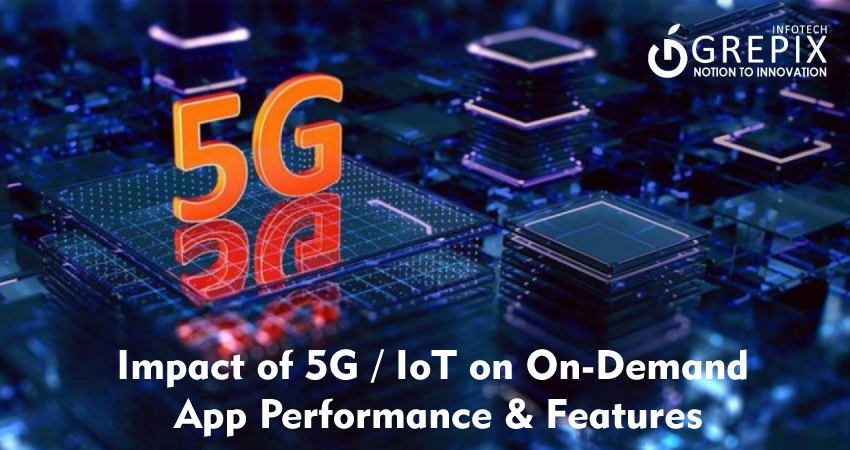Impact of 5G / IoT on On-Demand App Performance & Features
5G on-demand apps and IoT app features are at the heart of digital transformation in 2025, enabling instantaneous access, real-time visibility, and seamless user experiences. Businesses across logistics, retail, healthcare, and urban mobility are leveraging these technologies for unparalleled performance and future-ready apps that anticipate, adapt, and evolve. Let’s explore the mechanics and impact of this technological revolution.
In 2025, the convergence of 5G on-demand apps and advanced IoT app features has fundamentally transformed real-time tracking and app performance for businesses and consumers. Powered by ultra-fast speeds, low latency, and edge computing, on-demand platforms now deliver near-instant interactions, personalized experiences, and robust IoT integration that scales across industries from healthcare and logistics to smart cities and mobility. This article delves into how 5G networks and IoT technology, supported by real-life examples and market statistics, redefine mobile app capabilities. Read on to discover actionable insights, future innovations, and expert answers to your top FAQs on achieving superior app performance and user satisfaction in 2025.
1The Role of 5G in Latency Reduction
What Makes 5G a Game Changer?
The fifth generation of wireless technology (5G) is more than just an upgrade in speed it’s a essential shift in how devices communicate, process, and respond. The hallmark of 5G for app developers is drastic latency reduction, with lag times dropping from 30–50 milliseconds on 4G to just 1 millisecond. This enables real-time synchronization, instantaneous responses, and a new era of hyper-responsive apps.
Real-Life Impact: Performance Metrics
- Speed: Multi-Gbps speeds dwarf 4G, making large file transfers and media streaming lightning fast.
- Load Times: Median app load times fall under 1 second, boosting user retention by up to 20% for brands like ZYNO (fintech).
- Reliability: Massive MIMO technology ensures stable connections in high-density urban environments; apps for event planning and urban mobility thrive under these conditions.
- Real-Time Communication: Video calls, multiplayer gaming, and live trading platforms are now engineered for immediacy rather than just basic connectivity.
Developer Paradigms Shift
With 5G’s capabilities, developers can create cloud-native experiences, prioritize modular builds, and leverage edge servers for next-level performance. Live AR multiplayer games, AI-based tutoring apps, and predictive maintenance become scalable realities.
2IoT-Enabled Features Transforming Mobile Apps
What Is IoT in On-Demand Apps?
The Internet of Things (IoT) enables apps to interact with smart devices sensors, wearables, connected vehicles in real time. By integrating IoT, app developers create seamless networks of devices and data streams that communicate instantly across geographies and operating contexts.Core IoT App Features in 2025
- Asset and Location Tracking: Over 45% of companies now use IoT for location tracking, directly impacting revenue by up to 1.6% through optimized asset utilization and theft mitigation.
- Smart Home Automation: Apps such as Samsung SmartThings and Philips Hue let users control lights, appliances, and security systems for personalized convenience.
- Healthcare Monitoring: Apps like UBreez track air quality, patient vitals, and deliver real-time diagnostics for remote healthcare providers.
- Fleet and Logistics Management: Platforms like Zubie deliver real-time GPS tracking, vehicle health updates, and driver performance monitoring for fleets and rentals.
- Fitness and Wellness Tracking: Fitbit’s real-time analytics guide users toward health goals, showing the reach of IoT-enabled features for consumer engagement.
Case Study: UBreez IoT-Driven Air Quality Control
UBreez exemplifies IoT’s practical value: using a cloud-connected device and app, users monitor indoor air conditions, customize alerts, and ensure compliance for health and productivity. Businesses leveraging such solutions are projected to collectively save up to $150 billion annually in operational costs.
3Real-Time Tracking with IoT & 5G Apps
Why Real-Time Matters
Real-time data capture and processing are fundamental demands for modern on-demand apps. Instantaneous feedback, monitoring, and predictive analytics create safer, smarter services. Whether tracking a food delivery, managing a supply chain, or monitoring patient vitals, real-time tracking is now a standard, not a premium feature.
Top Use Cases for Real-Time IoT Tracking
- Supply Chain Optimization: Reduce dead time, route inefficiency, and lost assets in factories, warehouses, and outdoor worksites.
- Urban Mobility: Apps adjust public transport routes, optimize ride-sharing, and reduce congestion in real time.
- Healthcare: Continuous monitoring for remote patients—IoT devices (wearables, implants) send instant alerts and updates to medical providers.
- Retail & E-Commerce: Real-time checkout, AR-based try-ons, and location-aware promotions increase engagement.
Statistics & Market Size
- Connected Devices: 18.8 billion IoT devices projected globally by end of 2024, up 13% YoY.
- Adoption Rate: Location tracking is the top IoT use case, and over 88% of energy companies prioritize cybersecurity incident response via IoT apps.
- Revenue Improvement: IoT location tracking yields average revenue boosts of 1.6% for sellers of connected products.
Also Read: Accelerating Your Fortune: Becoming a Billionaire in South Africa's Taxi Industry
4Future Innovation: 5G & IoT for Next-Gen On-Demand Apps
Cloud-Native and Edge Computing
With 75% of enterprise data processed at the edge by 2025 (up from 10% in 2020), apps rely more on distributed cloud infrastructure. Algorithms for language processing, image recognition, and predictive maintenance run locally, providing instant insights and reducing network burden.
AR, VR & XR Becoming Mainstream
Thanks to 5G on-demand apps, AR/VR experiences thrive: immersive retail, virtual in-store navigation, and collaborative design now operate without latency bottlenecks. Medical professionals employ AR overlays in surgical procedures; urban planners visualize live traffic via IoT sensors.
AI & Predictive Analytics
5G and IoT synergize to deliver context-aware and anticipative features. Apps proactively suggest next actions workout adjustments based on real-time biometrics, price updates in retail based on your geolocation and shopping history.
Emerging Sectors
- Healthcare: Telemedicine app usage projected to grow, with real-time video and diagnostics powered by IoT sensors and wearables.
- Logistics & Autonomous Vehicles: Low latency enables split-second decision-making for autonomous fleets and real-time delivery tracking, directly impacting safety, efficiency, and customer experience.
- Smart Cities: Interconnected apps oversee traffic systems, public safety, waste management with real-time sensor data.
Also Read: "Cost Optimization: How On-Demand Apps Can Reduce Operational Expenses"
5Numbered List: Key Takeaways for App Developers
- Prioritize 5G on-demand apps with integrated IoT features for scalable, future-proof solutions.
- Optimize user flows for ultra-fast load times and minimal latency.
- Design apps for modular builds and edge computing to harness cloud-native advantages.
- Include real-time tracking and predictive analytics to increase operational efficiency and customer trust.
- Test performance under high device density and data throughput scenarios to guarantee robust reliability.
- Leverage AR/VR and AI for immersive, context-aware app experiences.
- Monitor security and compliance with IoT devices in sensitive sectors like healthcare and finance.
6Bullet List: Future-Ready Features to Integrate
- Real-time GPS & location tracking via IoT sensors
- Edge computing for instant data processing
- AR-enabled navigation and virtual retail experiences
- Automated fleet management and logistics dashboards
- Smart home/building controls for lighting, security, and appliances
- Healthcare monitoring with live patient data feeds
- AI-powered personalized recommendations and context-aware notifications
Conclusion
The fusion of 5G on-demand apps and cutting-edge IoT app features in 2025 marks a paradigm shift in mobile app performance, scalability, and user engagement. Ultra-fast, low-latency networks and real-time tracking IoT apps have enabled industries to evolve from reactive workflows to predictive, adaptive experiences rooted in real-time data and edge computing. Businesses benefit from reduced operational costs, enhanced security, increased customer satisfaction, and new revenue streams. The path forward involves harnessing these tools for more secure, responsive, and innovative app solutions. Discover the difference partner with digital experts to build your next-generation app powered by 5G and IoT. Share this post with your network and future-proof your app strategy today
FAQs
1. How do 5G and IoT improve app speed and reliability?
5G drastically reduces latency to under 1 millisecond and multiplies network reliability, ensuring fast, uninterrupted interactions even amid heavy web traffic or device density. IoT enables instant data transmission between physical devices and apps for seamless automation and monitoring.
2. What are top IoT app features in 2025?
Key IoT features include real-time location tracking, smart home automation, continuous healthcare monitoring, fleet tracking, and context-aware personalization. These features drive business efficiency and user engagement.
3. Can 5G on-demand apps help reduce operational costs?
Yes! Real-time analytics, quicker load times, and predictive maintenance increase efficiency, reduce dead time, and cut operational expenses. For example, air quality control apps save up to $150 billion annually for businesses.
4. How does real-time tracking impact customer experience?
Real-time tracking eliminates wait times and uncertainty for consumers in delivery, mobility, and healthcare, improving satisfaction and trust. Businesses see revenue gains through optimized resource utilization.
5. What are leading industries benefiting from 5G and IoT app performance?
Healthcare, logistics, urban mobility, retail, and smart city operations are leading adopters. Their apps, powered by 5G and IoT, deliver superior outcomes in diagnostics, delivery, security, and customer engagement.
Launch your vision with our mobile app development company, where innovation meets excellence to create cutting edge mobile solutions.







